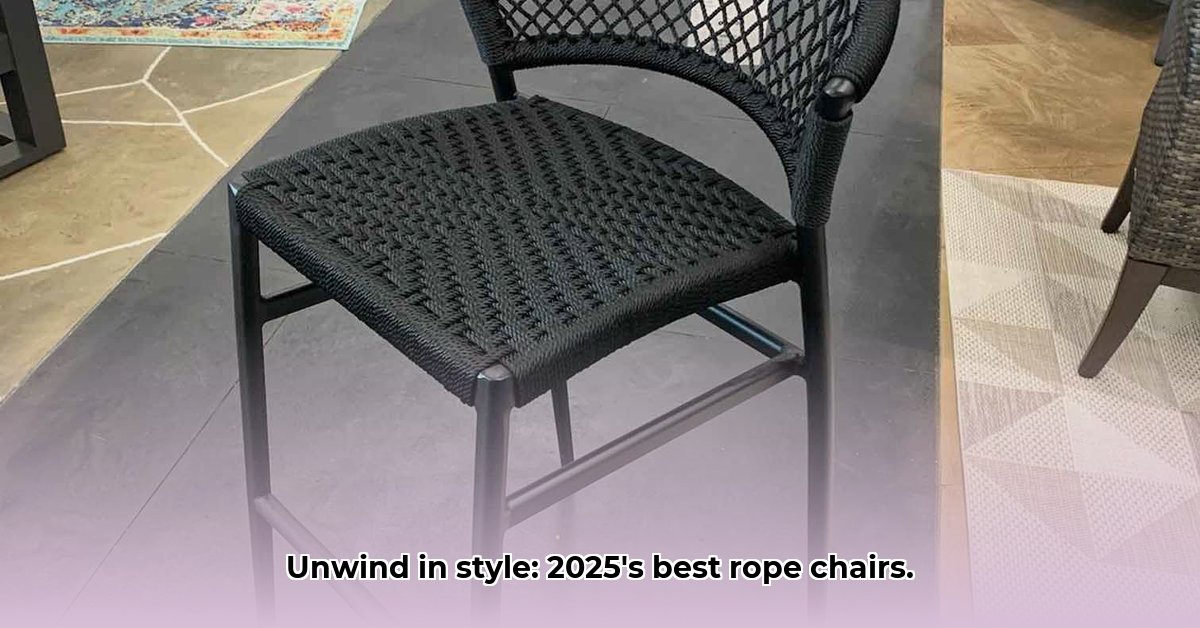Looking for a comfortable and stylish way to relax outdoors? Rope chairs are a popular choice, but with so many options available, finding the perfect one can feel overwhelming. This guide simplifies the process, covering everything from types (hanging, freestanding) to materials (durability, care), helping you choose the best rope chair for your space and budget. We’ll also highlight top picks and provide honest reviews to enhance your outdoor space. For a luxurious option, consider a rattan swivel chair.
Rope Chair 2025: Finding Your Perfect Outdoor Seating
Adding a rope chair to your patio, deck, or garden offers both comfort and style, creating a welcoming space for relaxation. Sifting through the numerous choices available can be daunting. This guide helps you navigate the world of rope chairs and provides insights to find the ideal one that meets your needs.
Exploring Types of Rope Chairs: Hammocks, Swings, Freestanding Seating, and More
Rope chairs are available in a variety of styles, each offering unique appeal and functionality. Here’s a breakdown of the main categories:
- Hanging Rope Chairs: These classic chairs hang from a sturdy support, swaying gently. Consider hammock-style chairs or porch swings. Ensure your chosen hanging point can safely support the weight. They offer a relaxing experience but require a suitable hanging location.
- Freestanding Rope Chairs: These chairs offer the same level of comfort as hanging chairs but without the need for installation. They feature wood, metal, or rope bases for stability and are perfect if you lack a hanging spot or prefer a more portable option.
- Rope Swings: Rope swings offer a playful and nostalgic seating option, perfect for adding a touch of whimsy to your outdoor space.
- Double Rope Chairs: Designed for couples or those who enjoy lounging with a friend, these chairs offer a wider seating area and increased weight capacity.
- Material Matters: The type of rope used significantly impacts the chair’s quality and durability. Cotton rope is soft and comfortable but less weather-resistant than synthetic options like polyester or polypropylene, which are designed for durability in various conditions. Many chairs combine materials, blending the comfort of cotton with the durability of a metal frame.
| Rope Chair Type | Advantages | Disadvantages | Best Location |
|---|---|---|---|
| Hanging | Relaxing, portable (sometimes), stylish, space-saving | Needs secure hanging spot, less stable, may require additional hardware for installation | Patio, porch, sturdy tree branch, indoor ceiling |
| Freestanding | Stable, versatile, no installation needed, suitable for any surface | Often heavier, not easily portable, can take up more floor space than hanging chairs | Deck, garden, poolside, balcony |
| Cotton Rope Chairs | Soft, natural look, comfortable, breathable | Less weather-resistant, requires more care and maintenance, prone to mildew | Covered porch, shady spot, sunroom |
| Synthetic Rope Chairs | Durable, weather-resistant, easy to maintain, resistant to fading and mildew | May feel less soft than cotton, less traditionally stylish, can sometimes feel less breathable in hot weather | Any outdoor location, exposed to the elements, poolside, high-humidity areas |
Material Selection: Balancing Durability, Style, and Weather Resistance
The materials used significantly influence a rope chair’s appearance, lifespan, and maintenance requirements. Let’s examine key components to consider when evaluating material selection.
- Rope Types: Natural fibers like cotton or jute offer a rustic appeal and a soft feel but are more prone to fading, mildew, and weather damage. Synthetic ropes, such as polyester, nylon, or polypropylene, provide better weather resistance, durability, and UV protection, lasting longer with regular exposure to the elements. Choosing between aesthetics and longevity is essential and impacts your maintenance commitment.
- Frame Material: Wood frames, such as teak, acacia, or eucalyptus, add elegance and durability but require regular maintenance to prevent weathering, rot, and insect damage. Metal frames, typically made of powder-coated steel or aluminum, offer sturdiness and weather resistance but may lack the aesthetic appeal of wood. Aluminum is lighter and rust-resistant, while steel is stronger but can rust if the powder coating is damaged.
- Cushions and Fabrics: Many rope chairs include cushions for added comfort. Look for cushions made with weather-resistant fabrics like Sunbrella or Olefin, which are designed to withstand sun, rain, and mildew. Ensure the cushion covers are removable and washable for easy cleaning.
A Practical Buying Guide for Rope Chairs: Prioritizing Your Needs and Preferences
Selecting the perfect rope chair requires careful planning and consideration of your specific needs and preferences. Use this checklist as you prioritize your needs when looking for rope chairs.
- Budget: Rope chair prices vary significantly based on materials, quality, and brand. Set a realistic budget before browsing to avoid overspending. Consider the long-term cost, including maintenance and potential repairs.
- Space: Measure your available space, including allowance for swing radius if you’re considering a hanging chair. Ensure the chair will fit comfortably when someone is sitting in it, without obstructing pathways or other furniture. Freestanding chairs also require adequate floor space.
- Style: Consider the overall design and aesthetic. Do you want something modern, rustic, bohemian, or traditional? Choose a style that complements your existing outdoor furniture and décor. Consider the color and texture of the rope and frame.
- Durability: Consider the weather conditions in your area. If you live in a rainy climate or plan to leave the furniture outdoors year-round, prioritize weather-resistant materials and construction. Evaluate the rope’s UV resistance, the frame’s rust resistance, and the cushion’s water resistance.
- Comfort: Consider the ergonomics of the chair. Does it provide adequate back support? Is the seat depth comfortable? Are cushions included, and are they made of comfortable materials?
- Weight Capacity: Ensure the chair’s weight capacity is sufficient for all users. Check the manufacturer’s specifications before purchasing.
- Maintenance: Consider the amount of maintenance required to keep the chair in good condition. Natural materials require more frequent cleaning and protection than synthetic materials.
- Warranty: Look for chairs with a warranty to protect against defects in materials and workmanship.
Top Rope Chair Picks for 2025: Expert Recommendations (Coming Soon)
Note: This section will be updated with specific product reviews, ratings (e.g., out of 5 stars), and images once product testing is complete. We’ll showcase a range of options to suit various tastes and budgets.
Proper Maintenance: Extending the Lifespan and Appearance of your Rope Chair
Proper care and maintenance significantly extend your rope chair’s lifespan and maintain its appearance. Here are some essential maintenance tips.
- Regular Cleaning: Dust the chair regularly with a soft brush or cloth to remove loose dirt and debris. Address stains quickly to prevent them from setting. Use a mild soap and warm water solution for both cotton and synthetic ropes. For tougher stains, consider using a specialized outdoor furniture cleaner.
- Weather Protection: Store natural fiber chairs indoors during storms or harsh weather to prevent water damage and mildew growth. Use a waterproof cover to protect synthetic rope chairs from rain and sun.
- Regular Inspections: Periodically check the chair for loose ropes, fraying, or other damage. Address any issues promptly to prevent them from worsening. Tighten any loose screws or bolts and replace any damaged components.
- UV Protection: Apply a UV protectant spray to synthetic ropes to prevent fading and degradation from sun exposure.
- Cushion Care: Clean cushions regularly according to the manufacturer’s instructions. Store cushions indoors when not in use to protect them from rain and sun.
Choosing a rope chair is a personal decision, and this guide provides the information you need to make the best choice for your lifestyle and outdoor space. Enjoy relaxing in your new rope chair!
How to Maintain Outdoor Rope Chairs for Long-Term Durability
Key Takeaways:
- Regular cleaning prevents dirt buildup, mold, and mildew, which extends the chair’s life.
- Protecting from weather elements, such as sun and rain, is essential to prevent fading and damage.
- Different materials require specific cleaning and maintenance techniques.
- Timely repairs prevent minor issues from escalating into major problems.
Types of Rope Chairs: A Quick Overview of Styles and Construction
Before diving into maintenance, consider the available types of rope chairs. Whether you prefer a hanging hammock, a freestanding model, or a swing will influence maintenance. Material choices also vary, featuring synthetic or natural fibers, each requiring specific care. Don’t forget the frame – whether made of wood, metal, or rope – as each material affects cleaning and protection strategies.
Choosing the Best Materials: Maximizing Durability and Minimizing Maintenance
Understanding your chair’s materials is key to how to maintain outdoor rope chairs for long-term durability. Synthetic ropes (polyester, nylon, polypropylene) are tougher and easier to clean than natural fibers (cotton, jute, hemp). Synthetic ropes often resist fading and mildew, but can still degrade with prolonged sun exposure. Natural fibers offer charm and a softer feel but are susceptible to moisture damage and require gentle cleaning. Wooden and metal frames require protection against rot/insects and rust, respectively.
- Gray Kitchen Backsplash Tile: Ideas for a Stylish Upgrade - December 14, 2025
- Backsplash For Gray Cabinets: Choosing the Right Backsplash Style - December 13, 2025
- Gray And White Backsplash: Ideas For Timeless Style - December 12, 2025









